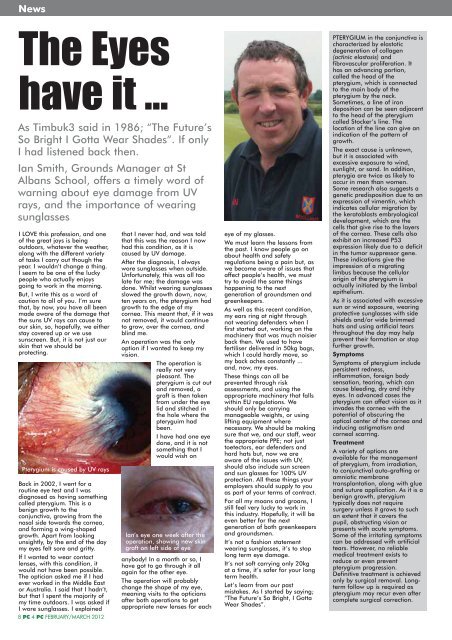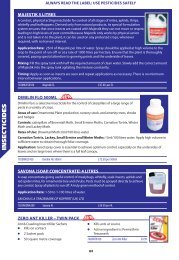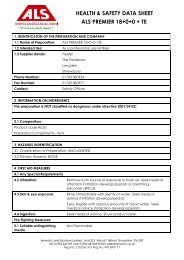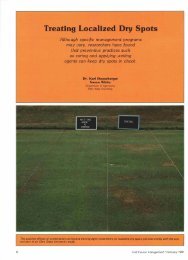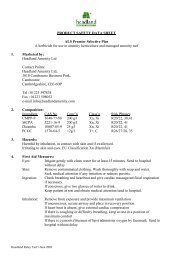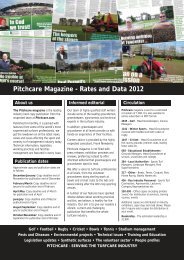these Open Championship Clubs choose to relief grind - Pitchcare
these Open Championship Clubs choose to relief grind - Pitchcare
these Open Championship Clubs choose to relief grind - Pitchcare
Create successful ePaper yourself
Turn your PDF publications into a flip-book with our unique Google optimized e-Paper software.
News<br />
The Eyes<br />
have it ...<br />
As Timbuk3 said in 1986; “The Future’s<br />
So Bright I Gotta Wear Shades”. If only<br />
I had listened back then.<br />
Ian Smith, Grounds Manager at St<br />
Albans School, offers a timely word of<br />
warning about eye damage from UV<br />
rays, and the importance of wearing<br />
sunglasses<br />
I LOVE this profession, and one<br />
of the great joys is being<br />
outdoors, whatever the weather,<br />
along with the different variety<br />
of tasks I carry out though the<br />
year. I wouldn’t change a thing.<br />
I seem <strong>to</strong> be one of the lucky<br />
people who actually enjoys<br />
going <strong>to</strong> work in the morning.<br />
But, I write this as a word of<br />
caution <strong>to</strong> all of you. I’m sure<br />
that, by now, you have all been<br />
made aware of the damage that<br />
the suns UV rays can cause <strong>to</strong><br />
our skin, so, hopefully, we either<br />
stay covered up or we use<br />
sunscreen. But, it is not just our<br />
skin that we should be<br />
protecting.<br />
Pterygium is caused by UV rays<br />
Back in 2002, I went for a<br />
routine eye test and I was<br />
diagnosed as having something<br />
called pterygium. This is a<br />
benign growth <strong>to</strong> the<br />
conjunctiva, growing from the<br />
nasal side <strong>to</strong>wards the cornea,<br />
and forming a wing-shaped<br />
growth. Apart from looking<br />
unsightly, by the end of the day<br />
my eyes felt sore and gritty.<br />
If I wanted <strong>to</strong> wear contact<br />
lenses, with this condition, it<br />
would not have been possible.<br />
The optician asked me if I had<br />
ever worked in the Middle East<br />
or Australia. I said that I hadn’t,<br />
but that I spent the majority of<br />
my time outdoors. I was asked if<br />
I wore sunglasses. I explained<br />
8 PC 4 PC FEBRUARY/MARCH 2012<br />
that I never had, and was <strong>to</strong>ld<br />
that this was the reason I now<br />
had this condition, as it is<br />
caused by UV damage.<br />
After the diagnosis, I always<br />
wore sunglasses when outside.<br />
Unfortunately, this was all <strong>to</strong>o<br />
late for me; the damage was<br />
done. Whilst wearing sunglasses<br />
slowed the growth down, now,<br />
ten years on, the pterygium had<br />
growth <strong>to</strong> the edge of my<br />
cornea. This meant that, if it was<br />
not removed, it would continue<br />
<strong>to</strong> grow, over the cornea, and<br />
blind me.<br />
An operation was the only<br />
option if I wanted <strong>to</strong> keep my<br />
vision.<br />
The operation is<br />
really not very<br />
pleasant. The<br />
pterygium is cut out<br />
and removed, a<br />
graft is then taken<br />
from under the eye<br />
lid and stitched in<br />
the hole where the<br />
pteryguim had<br />
been.<br />
I have had one eye<br />
done, and it is not<br />
something that I<br />
would wish on<br />
Ian’s eye one week after the<br />
operation, showing new skin<br />
graft on left side of eye<br />
anybody! In a month or so, I<br />
have got <strong>to</strong> go through it all<br />
again for the other eye.<br />
The operation will probably<br />
change the shape of my eye,<br />
meaning visits <strong>to</strong> the opticians<br />
after both operations <strong>to</strong> get<br />
appropriate new lenses for each<br />
eye of my glasses.<br />
We must learn the lessons from<br />
the past. I know people go on<br />
about health and safety<br />
regulations being a pain but, as<br />
we become aware of issues that<br />
affect people’s health, we must<br />
try <strong>to</strong> avoid the same things<br />
happening <strong>to</strong> the next<br />
generation of groundsmen and<br />
greenkeepers.<br />
As well as this recent condition,<br />
my ears ring at night through<br />
not wearing defenders when I<br />
first started out, working on the<br />
machinery that was much noisier<br />
back then. We used <strong>to</strong> have<br />
fertiliser delivered in 50kg bags,<br />
which I could hardly move, so<br />
my back aches constantly ...<br />
and, now, my eyes.<br />
These things can all be<br />
prevented through risk<br />
assessments, and using the<br />
appropriate machinery that falls<br />
within EU regulations. We<br />
should only be carrying<br />
manageable weights, or using<br />
lifting equipment where<br />
necessary. We should be making<br />
sure that we, and our staff, wear<br />
the appropriate PPE; not just<br />
<strong>to</strong>etec<strong>to</strong>rs, ear defenders and<br />
hard hats but, now we are<br />
aware of the issues with UV,<br />
should also include sun screen<br />
and sun glasses for 100% UV<br />
protection. All <strong>these</strong> things your<br />
employers should supply <strong>to</strong> you<br />
as part of your terms of contract.<br />
For all my moans and groans, I<br />
still feel very lucky <strong>to</strong> work in<br />
this industry. Hopefully, it will be<br />
even better for the next<br />
generation of both greenkeepers<br />
and groundsmen.<br />
It’s not a fashion statement<br />
wearing sunglasses, it’s <strong>to</strong> s<strong>to</strong>p<br />
long term eye damage.<br />
It’s not soft carrying only 20kg<br />
at a time, it’s safer for your long<br />
term health.<br />
Let’s learn from our past<br />
mistakes. As I started by saying;<br />
“The Future’s So Bright, I Gotta<br />
Wear Shades”.<br />
PTERYGIUM in the conjunctiva is<br />
characterized by elas<strong>to</strong>tic<br />
degeneration of collagen<br />
(actinic elas<strong>to</strong>sis) and<br />
fibrovascular proliferation. It<br />
has an advancing portion,<br />
called the head of the<br />
pterygium, which is connected<br />
<strong>to</strong> the main body of the<br />
pterygium by the neck.<br />
Sometimes, a line of iron<br />
deposition can be seen adjacent<br />
<strong>to</strong> the head of the pterygium<br />
called S<strong>to</strong>cker’s line. The<br />
location of the line can give an<br />
indication of the pattern of<br />
growth.<br />
The exact cause is unknown,<br />
but it is associated with<br />
excessive exposure <strong>to</strong> wind,<br />
sunlight, or sand. In addition,<br />
pterygia are twice as likely <strong>to</strong><br />
occur in men than women.<br />
Some research also suggests a<br />
genetic predisposition due <strong>to</strong> an<br />
expression of vimentin, which<br />
indicates cellular migration by<br />
the kera<strong>to</strong>blasts embryological<br />
development, which are the<br />
cells that give rise <strong>to</strong> the layers<br />
of the cornea. These cells also<br />
exhibit an increased P53<br />
expression likely due <strong>to</strong> a deficit<br />
in the tumor suppressor gene.<br />
These indications give the<br />
impression of a migrating<br />
limbus because the cellular<br />
origin of the pterygium is<br />
actually initiated by the limbal<br />
epithelium.<br />
As it is associated with excessive<br />
sun or wind exposure, wearing<br />
protective sunglasses with side<br />
shields and/or wide brimmed<br />
hats and using artificial tears<br />
throughout the day may help<br />
prevent their formation or s<strong>to</strong>p<br />
further growth.<br />
Symp<strong>to</strong>ms<br />
Symp<strong>to</strong>ms of pterygium include<br />
persistent redness,<br />
inflammation, foreign body<br />
sensation, tearing, which can<br />
cause bleeding, dry and itchy<br />
eyes. In advanced cases the<br />
pterygium can affect vision as it<br />
invades the cornea with the<br />
potential of obscuring the<br />
optical center of the cornea and<br />
inducing astigmatism and<br />
corneal scarring.<br />
Treatment<br />
A variety of options are<br />
available for the management<br />
of pterygium, from irradiation,<br />
<strong>to</strong> conjunctival au<strong>to</strong>-grafting or<br />
amniotic membrane<br />
transplantation, along with glue<br />
and suture application. As it is a<br />
benign growth, pterygium<br />
typically does not require<br />
surgery unless it grows <strong>to</strong> such<br />
an extent that it covers the<br />
pupil, obstructing vision or<br />
presents with acute symp<strong>to</strong>ms.<br />
Some of the irritating symp<strong>to</strong>ms<br />
can be addressed with artificial<br />
tears. However, no reliable<br />
medical treatment exists <strong>to</strong><br />
reduce or even prevent<br />
pterygium progression.<br />
Definitive treatment is achieved<br />
only by surgical removal. Longterm<br />
follow up is required as<br />
pterygium may recur even after<br />
complete surgical correction.


